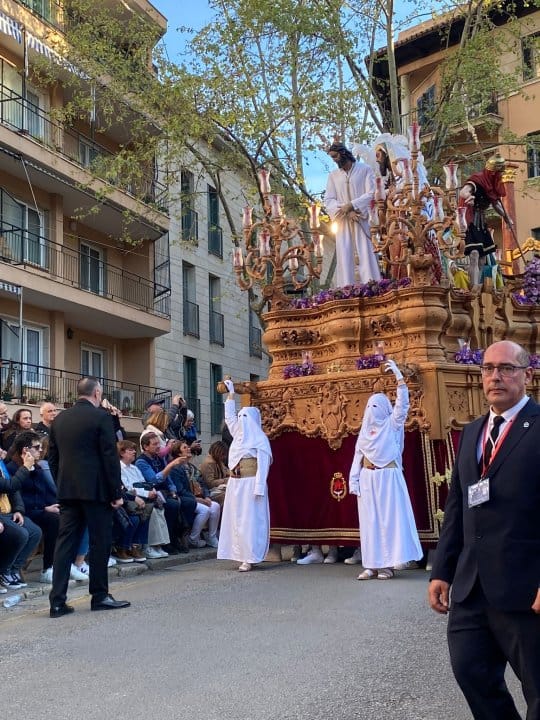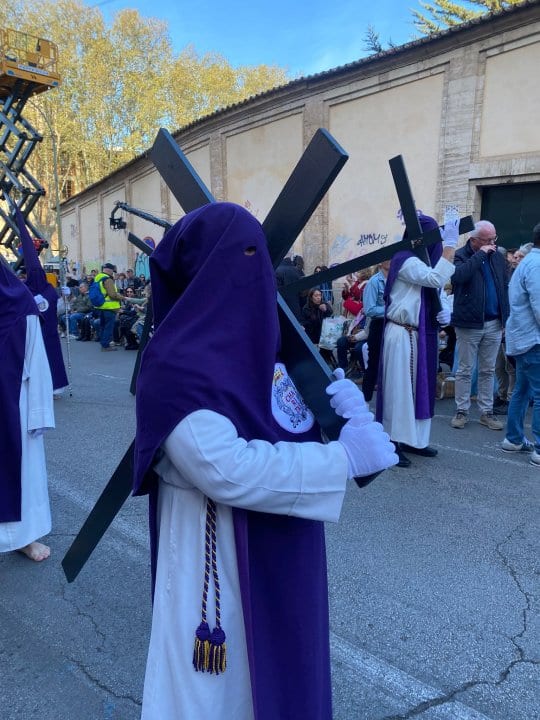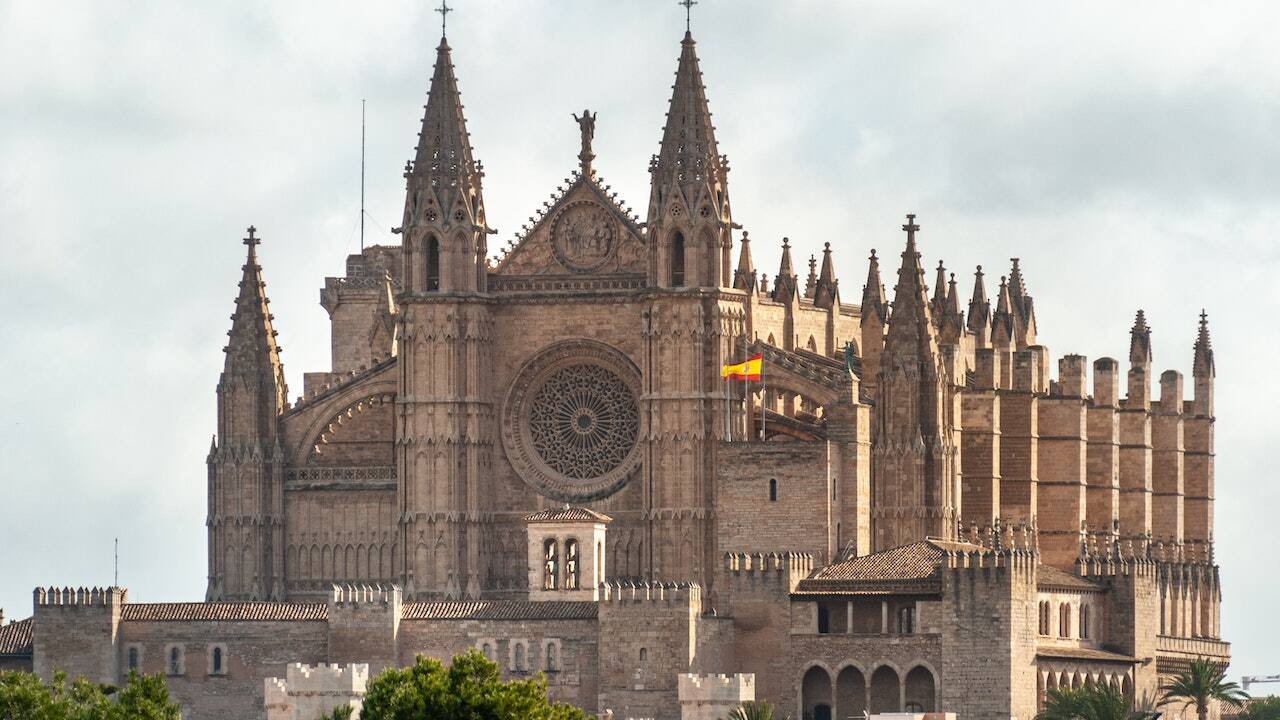



Mallorca is the epitome of everything Mediterranean: from hypnotically blue ocean, to fresh fish and white wine for lunch. The largest of Spain’s Balearic Islands, it is fertile hunting grounds for celebrity spotting, with A-list actors like Michael Douglas, top models like Claudia Schiefer, and business tycoons like Richard Branson, all having bought properties here.
It is also where the more discerning among Spain’s domestic travellers head to spend the long, hot summers, sunning themselves on beaches while sipping haute-cocktails.
But visiting the island, as we did, during Semana Santa (holy week) the seven days between Palm Sunday and Easter Sunday – is an entirely different experience. In the global imagination, Easter might conjure images of bunnies and chocolate eggs, but in Spain, melancholy is the dominant mood.
 Cristo de la Sangre. (Photo courtesy Pallavi Aiyar)
Cristo de la Sangre. (Photo courtesy Pallavi Aiyar)
In Palma, Mallorca’s capital city, the main Easter procession is called the Cristo de la Sangre – the Christ of the blood - the name itself hinting that bunnies are unlikely to make an appearance. We wended our way to the starting point in the early evening, to get ringside positions. A few candles already lit the gloaming as we took up our places. Ghostly figures shrouded in robes, rustling capes and pointed hoods with slits only for the eyes, were milling about. Some of these were incongruously taking selfies. Others chatted with tourists despite their forbidding appearance.
It was a shocking sight at first, because the clothing was so reminiscent of the white-supremacist Ku Klux Klan. But in fact, these robes predate the Klan by centuries. The conical head gear known as a capirote were first prescribed in Spain by the holy office of the Inquisition. Men and women arrested on suspicion of heresy had to wear a paper capirote in public as a mark of humiliation.
In time, the hood was adopted by the cofradia, or Catholic brotherhoods, so that their members could remain anonymous when they took to the streets to whip themselves bloody, in penance for their sins, in a very Muharram-like display of religious fervour. Although self-flagellation as a part of religious processions was eventually banned in 1777, in practice it continued till well into the 20th century.
In Mallorca there are 33 cofradia, each with their distinct colours and saints. The penitents, or nazarenos, were thankfully whip-free, but many walked barefoot despite the spring-chill. Others carried wooden crosses on their shoulders or had iron chains around their ankles. Suffering remained a conspicuous motif of the procession.
I took a photograph of a particularly frightening nazareno outfitted in purple cape and hood, who was carrying an enormous cross on his back. The penitent immediately stopped marching and turned to stare at me through the slits in his capirote. I was petrified, especially as he began to put his free hand into a pocket in his robes, as if to draw a weapon. But what emerged was only a printed card with the name of his brotherhood and an image of Christ, which he handed to me with an almost Japanese-like bow. No mean feat given the weight on his back.
 (Photo by Pallavi Aiyar)
(Photo by Pallavi Aiyar)
The procession was punctuated by dozens of pasos or floats. These are enormous structures, with life-sized idols of Jesus Christ on the cross, his face frozen in grief. Many featured the Virgin Mary as well. Most weigh a ton or two and about 40 people are required to hoist a paso on their heads. The carriers, called costaleros, stand directly under the tableaux and are hidden by fabric that falls on either side of the float. Only their feet are visible to onlookers.
Amidst the swirling currents of this most Catholic of cultural expressions, I glimpsed elements of Islam, paganism and even, Hinduism. For Easter in Spain bears imprints of the cultural mélange - Arabic, Hebrew, and Gypsy – that lies under the surface of the country. It is a substructure layered over by the debris of Catholicism, modernity and secularism, but exposed every once in a while, as during Holy Week.
The procession immediately put me in mind of Hindu festivals like Ganesh Chaturthi, where idols of the elephant God are carried by processions through the streets of cities before being immersed in the sea. There was in fact one incident in 2017, when a group of Hindus carrying an idol of Ganesha were welcomed into a church in the Spanish city of Ceuta, with the gathered Christian congregation bursting into spontaneous hymns to welcome it.
 Cathedral of Santa Maria of Palma. (Photo: David Vines via Pexels)
Cathedral of Santa Maria of Palma. (Photo: David Vines via Pexels)
As paso after paso wended its way past us to the beat of drumming and trumpets, our children began to get restless. Eventually, we left about two hours into the proceedings, but discovered that the processions carried on all night, ending only at dawn with the arrival of all the floats at the Palma cathedral.
The next few days of our trip were spent in more standard activities. We took a wooden train to Soller, a picturesque town nestled in the Mallorcan mountains. The scenery was breathtaking, with wildflowers carpeting the countryside. We ate paella by the beach and hiked a costal route to watch the sun set. But as I winged my way back to Madrid, it was the images of the procession of the Cristo de la Sangre that lingered in my head: Easter like no other.
Discover the latest Business News, Sensex, and Nifty updates. Obtain Personal Finance insights, tax queries, and expert opinions on Moneycontrol or download the Moneycontrol App to stay updated!
Find the best of Al News in one place, specially curated for you every weekend.
Stay on top of the latest tech trends and biggest startup news.